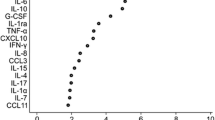Abstract
Background:
Components of the spirochete Borrelia burgdorferi sensu lato (B. burgdorferi s.l.) do not have chemotactic activity. However, B. burgdorferi s.l. causes a chemotactic response, probably by stimulating synthesis of cytokines of the chemokine family by host cells. Our aim was to confirm that the synthesis of chemokines is increased in Lyme borreliosis and that they may account for leukocyte migration, thus being involved in inflammatory response.
Materials and Methods:
We measured concentrations of chemokines: interleukin 8 (Il-8) and macrophage inflammatory protein 1α and 1β (MIP-1α, -1β) in serum of 20 patients with erythema migrans (early localized infection, group I), of 19 patients with Lyme arthritis (chronic infection, group II), and in serum and cerebrospinal fluid (CSF) of 20 patients with neuroborreliosis (early disseminated infection, group III), before and after 2 weeks of antibiotic therapy (examinations 1 and 2), as well as in the sera of 12 healthy blood donors and CSF of ten patients in whom Lyme borreliosis and meningitis were excluded (control group). Interleukin 1β (Il-1β) level in serum and CSF and pleocytosis of CSF were assessed simultaneously.
Results:
The mean concentrations of all studied chemokines in serum were significantly elevated in all study groups in examination 1 and decreased in examination 2. The concentration of Il-8 in serum was higher in group I and the concentration of MIP-1α in group III was higher in comparison with group II. Serum concentrations of all chemokines in group I and III correlated with the concentration of Il-1β, while in group II this correlation appeared only for Il-8 in examination 2. Concentrations of all chemokines in CSF were significantly increased, but as for MIP-1α and 1β they remained lower than in serum. The concentration of Il-8 in CSF was variable and reached values several fold higher than in the serum in some patients. There was no correlation between chemokine concentrations and CSF pleocytosis.
Conclusion:
The synthesis of chemokines (Il-8, MIP-1α and 1β) is increased in Lyme borreliosis and, at least in the early stages of the disease, is related to the synthesis of Il-1β. Chemokine concentrations depend on the clinical form of Lyme borreliosis, with a tendency for higher values in early infection (erythema migrans and neuroborreliosis). Of the chemokines studied, Il-8 created a chemotactic gradient towards the inflammation site, and thus might be responsible for leukocyte migration.
Similar content being viewed by others
Author information
Authors and Affiliations
Corresponding author
Rights and permissions
About this article
Cite this article
Grygorczuk, S., Pancewicz, S., Zajkowska, J. et al. Concentrations of Macrophage Inflammatory Proteins MIP-1α and MIP-1β and Interleukin 8 (Il-8) in Lyme Borreliosis. Infection 32, 350–355 (2004). https://doi.org/10.1007/s15010-004-3110-4
Received:
Accepted:
Issue Date:
DOI: https://doi.org/10.1007/s15010-004-3110-4




